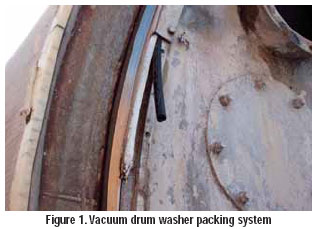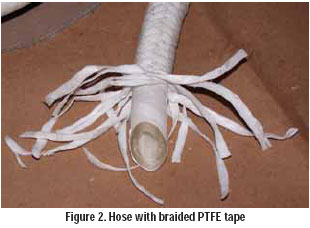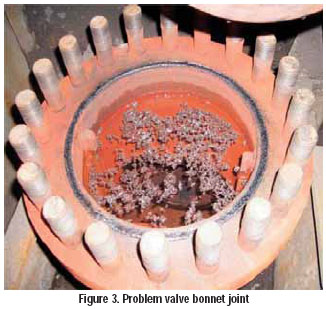Do you have a large rotating drum that cannot keep a vacuum, or a pump that uses an exorbitant amount of water annually just to keep the packing operating satisfactorily? What about a problematic flange joint?
Sealing a Large Rotating Drum
Problem
In a paper mill bleaching and rinsing process, a 12 ft diameter drum washer is designed to maintain a vacuum to pull water from the paper stock. The drum rotates at about 5 rpm and handles acidic bleach chemicals that are off the pH scale. The temperature is 160 deg F. Seals are required at both ends of the drum.
Anyone who has tried to seal a vacuum knows that nature abhors a vacuum. In addition, the old drum washer wobbles as it turns, so that vacuum is even more likely to be lost.
The packing needed to address these problems, including corrosive chemicals, moderate temperatures, imperfect rotation (run-out) and the need to maintain a vacuum.
Solution: Energized Compression Packing
The packing manufacturer's application specialist considered all factors and offered lubricated PTFE packing to withstand the corrosive media and temperature. The more difficult problem was how to maintain positive contact with the sealing surface to achieve a reliable seal. All packing has some degree of resilience, which is a property more associated with rubber, but PTFE packing is not particularly resilient.
A novel packing system was designed to create resilience and maintain positive seal contact as the drum wobbled through its rotations. An inflatable polymeric hose was installed behind the PTFE packing. The air pressure inside the hose added the needed resilience, enabling the packing to track the drum surface as it rotated (see Figure 1).
 |
This prospective solution, however, introduced a new problem-the hose's chemical compatibility. The strong bleach could degrade the hose, causing it to fail. Compression packing fabrication technology provided the solution, and the hose was wrapped with PTFE tape (see Figure 2).
 |
An effective wrapping could only be done with a compression packing braider. The tape was wrapped using a round braider, equipment common to any compression packing manufacturer. An added benefit of the solution to this tangential problem was that the burst strength of the tubing increased, allowing higher pressures that improved the seal's quality and life.
Result
The result was a long-lasting seal that held a vacuum under less than perfect conditions.
Problem
The pumps in a paper mill move condensate; circulate fluids, feed stocks and chemical liquors; and transfer bleach stock. Many of the fluids are mixed with abrasive solids that shorten packing life. Mechanical seals are often not suited for the abrasive fluids and worn equipment. The frequent replacement of packing adds the burden of additional packing purchases, labor hours to repack and lost production due to downtime.
Each pump handling abrasive fluids uses 4 gpm to flush destructive abrasives from the packing. This equates to 2,100,000 gallons/year/pump of wasted water into the pumped fluid. Additionally, energy is wasted to remove unwanted water from the media stream.
A paper mill, which contains many pumps, needed a solution to conserve the costly resources of water and energy.
Solution: Enhanced Compression Packing System
Given these issues, another packing solution may seem counterintuitive. However, there are packing systems specifically designed to work in abrasive fluids and reduce water consumption. An engineered combination of braided carbon fiber, braided flexible graphite, lantern rings and flush water flow controls combine to achieve the desired result. The graphite materials have low friction to accommodate a spinning pump shaft with little fluid to cool it. The lantern flush ring and flush controls keep out abrasives and keep the packing cool enough to operate with a long life.
Result
With installation of the updated packing system, the flush water required dropped to 0.5 gpm. The water savings amounted to 1,840,000 gallons/year/pump. An added benefit was less energy was wasted removing the water from the system media.
Problematic Flange Joint
Problem
In a coal-fired power plant-the domain of spiral wound and fabricated metal gaskets-a 50 year old gate valve was leaking steam at 1,020 deg F and 2,350 psi at its bonnet joint. The valve's bonnet flange sealing surface was worn, irregular, cut and scratched. The groove that received the gasket was uniform, but its depth now varied from 0.040 in to 0.120 in. Traditional gaskets would not seal due to expansion during thermal cycling and required frequent retightening or replacement (see Figure 3).

Solution: Compression Packing
Yes, braided packing works for a flange-not just for pumps and valve stems. A braid composed of flexible graphite and carbon fiber was installed in the groove of the valve's bonnet joint. The packing's ability to easily conform to surface imperfections and withstand high temperatures and pressures made it the best solution for the surfaces of the irregular flange.
Result
The bonnet joint was sealed, did not require re-tightening when thermally cycled and lasted longer than traditional gasket solutions.
Conclusion
The conformability, flexibility and wide range of material combinations and designs enable packing to seal many difficult, unconventional applications. These capabilities, coupled with other packing systems components, can provide effective sealing solutions that reduce the consumption of valuable water and energy resources.
If you have a sealing problem, consider a discussion with your packing manufacturer.
For more information on this topic see the following sections in the newly published FSA- ESA Compression Packing Technical Manual: How packing works, Valve packing types, Pump packing types, Specialty equipment packing, Advances in compression packing, Protocol for proper packing selection and Definition and uses of compression packing.
Pumps & Systems, February 2010
Next Month: What are the basics for applying expansion joints?

